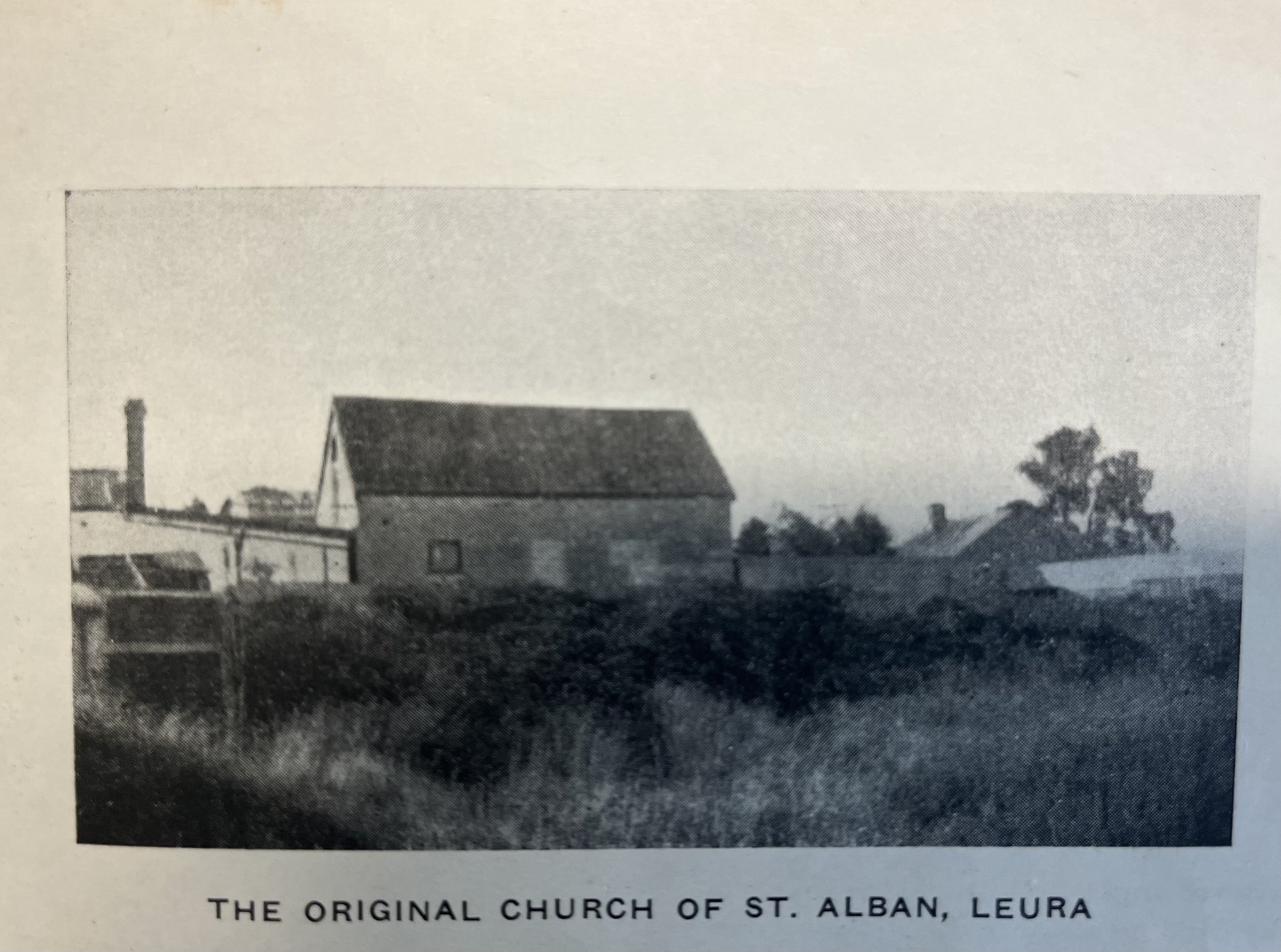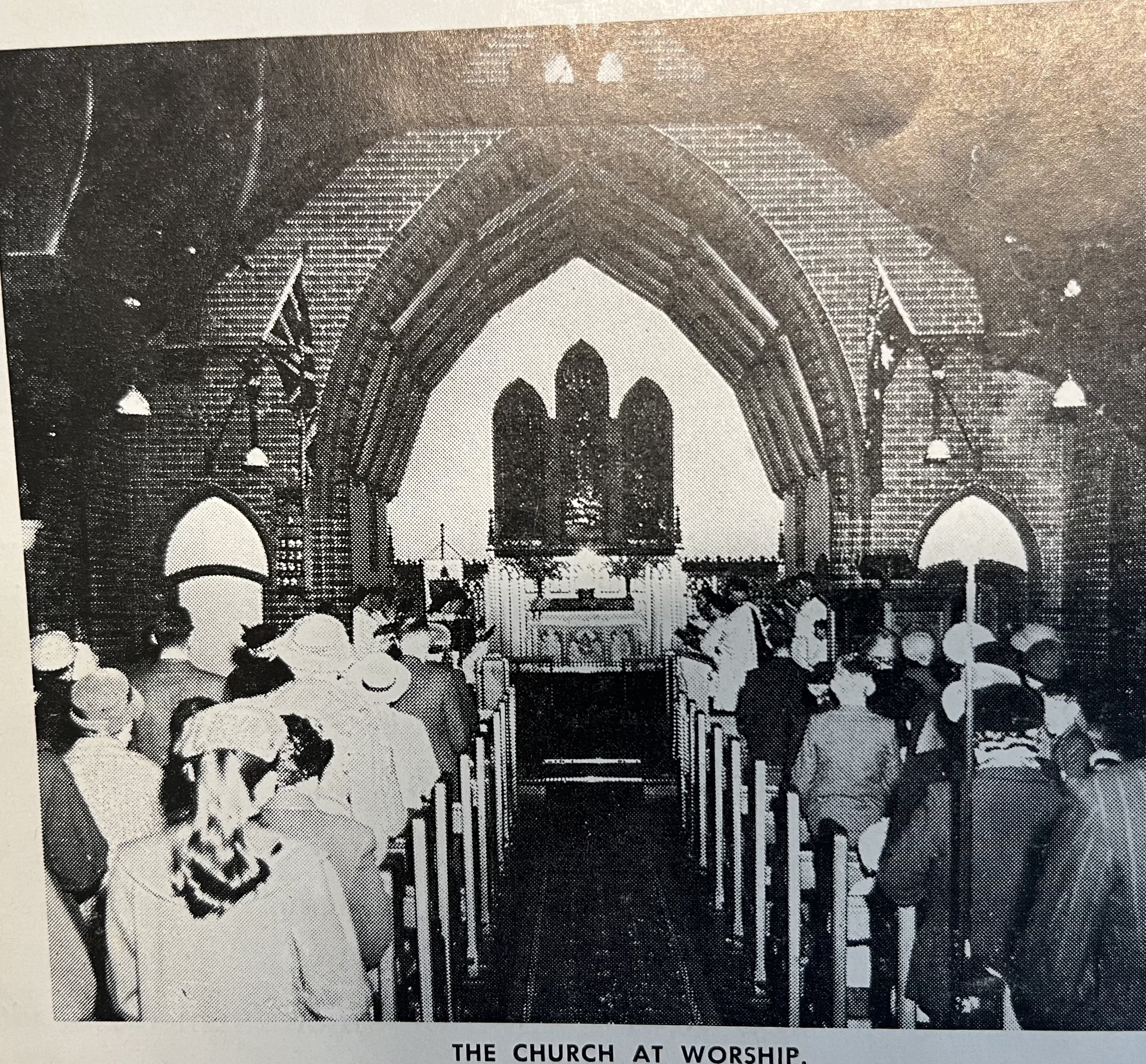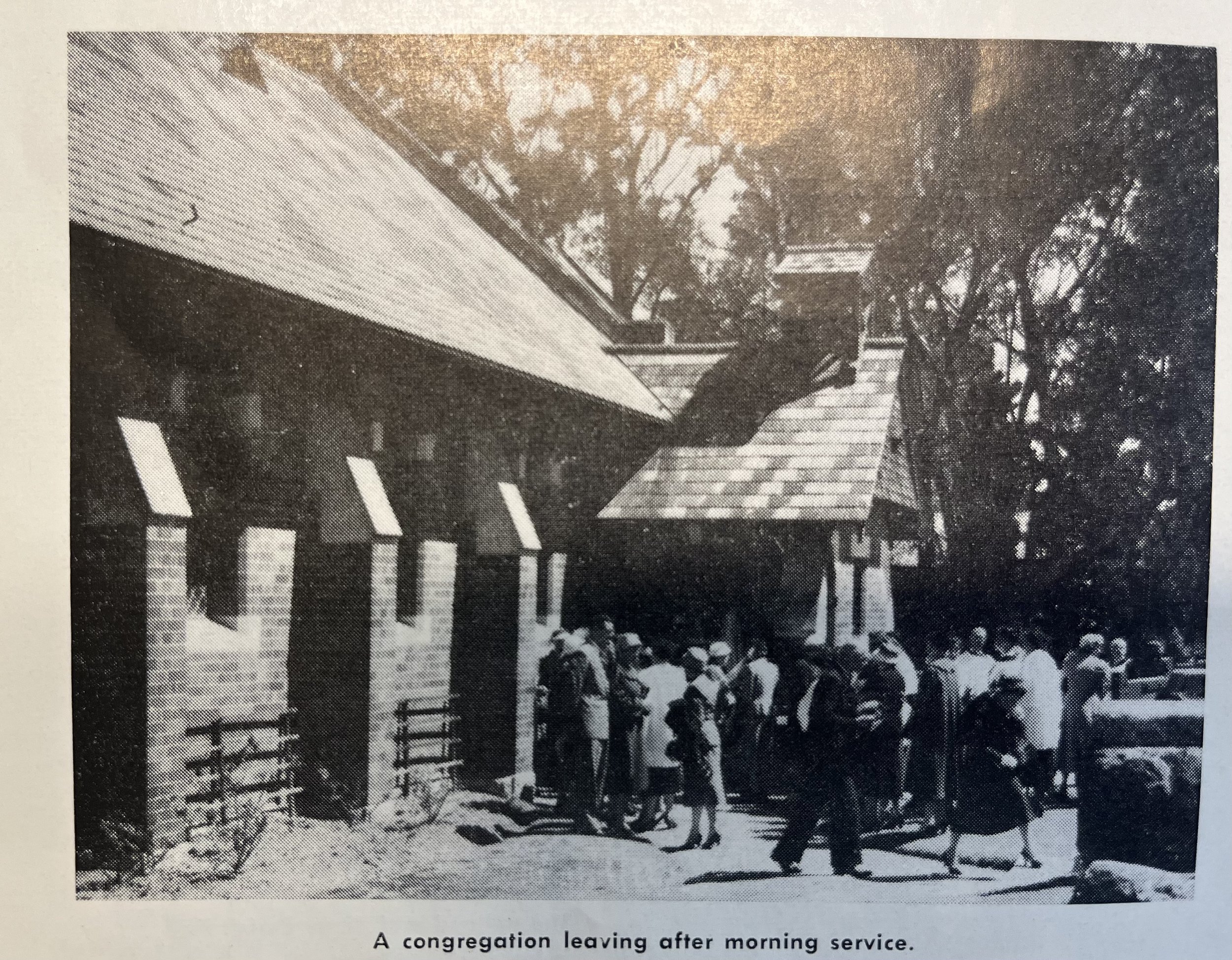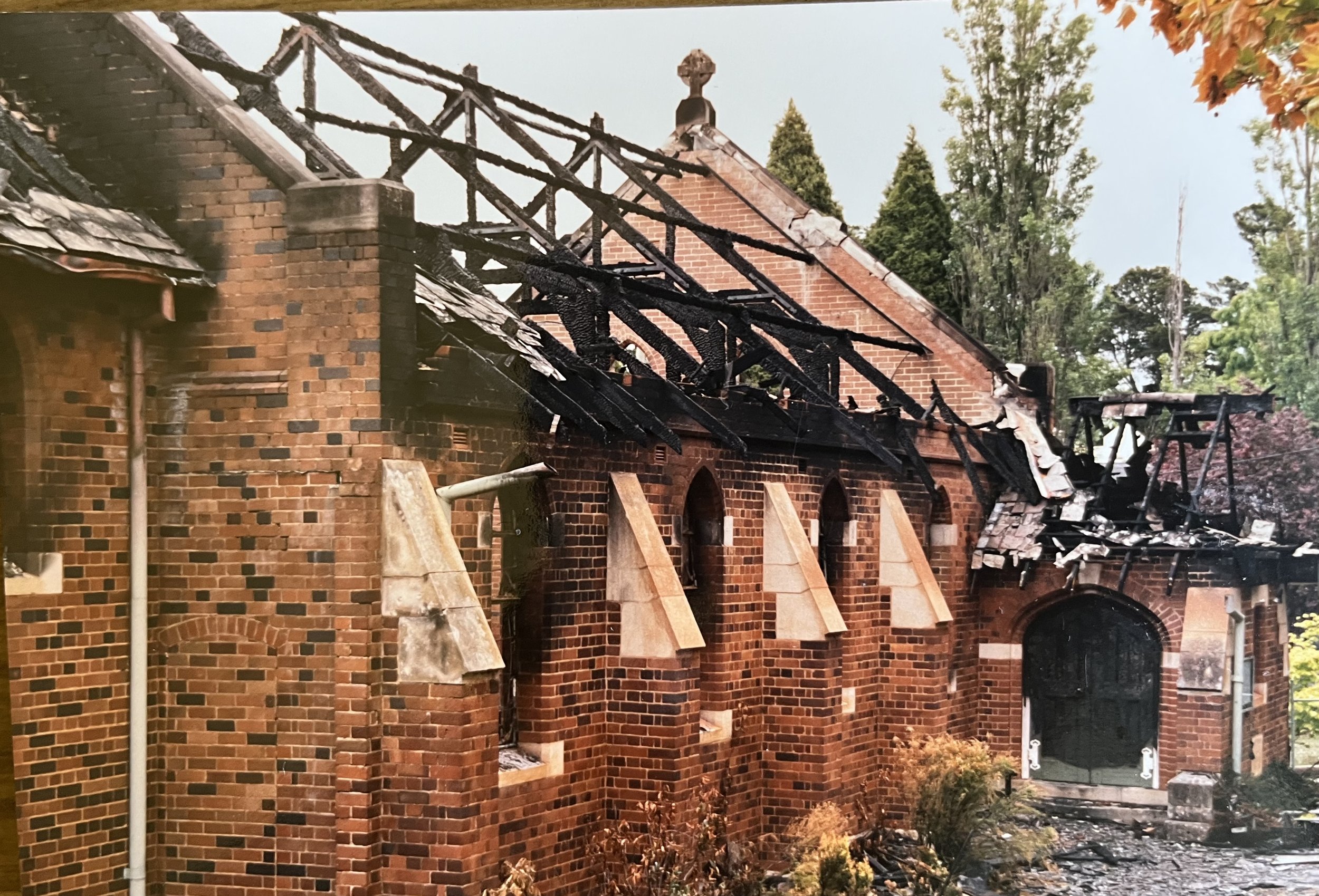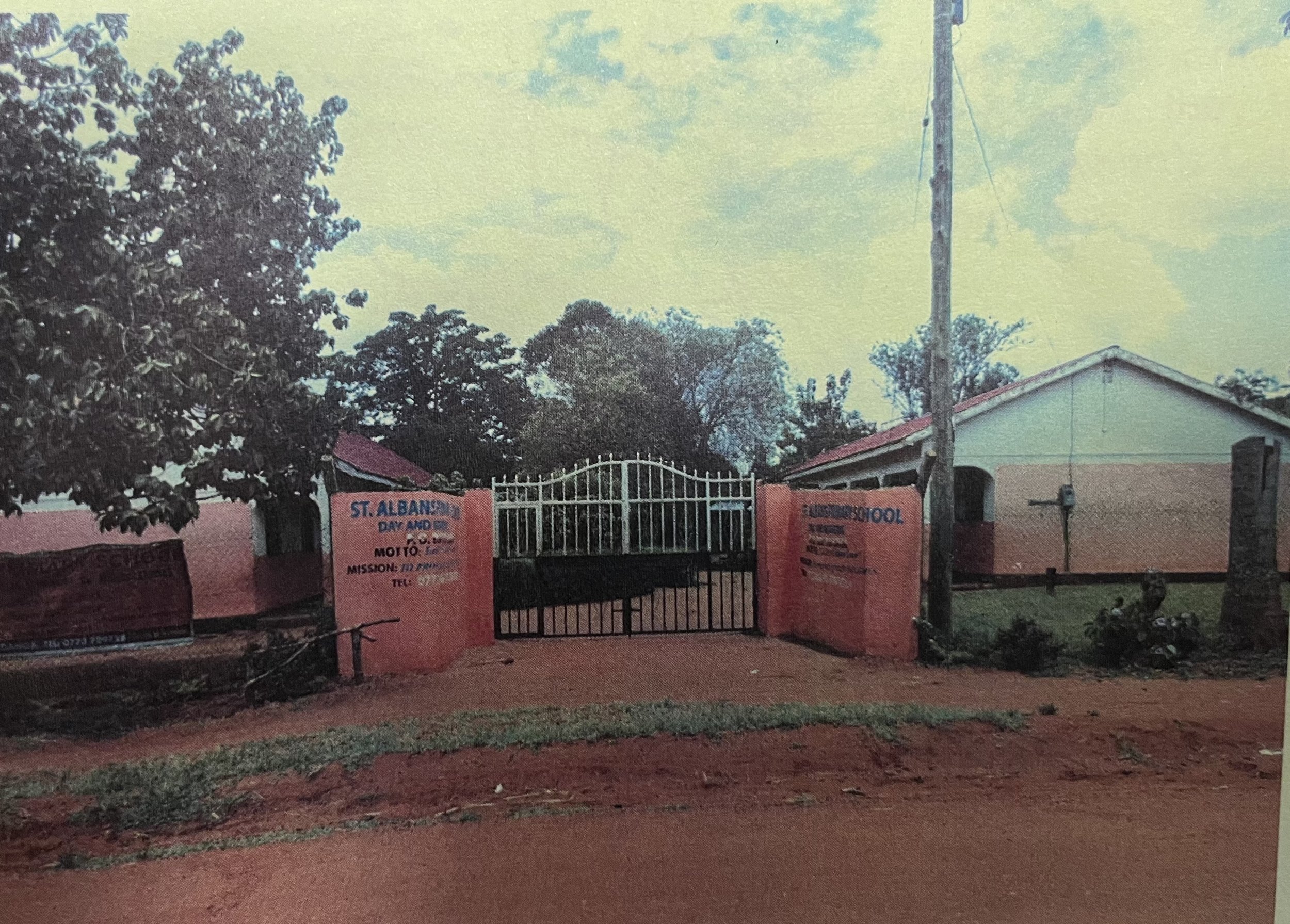
The History of St Alban’s Leura [1]
The first informal church service was held in Leura in 1897. The clergyman in charge of Katoomba walked over from his church in the company of two holiday makers to a small public hall opposite the Leura railway. A gale was howling on a cold and windy night and the congregation (the two of them) who came to worship did so without regular transport, footpaths, and streetlights. Leura at that stage was just a railway siding.
The first Church of England church in Leura was a small timber structure next to where "The Ritz" is now situated in the mall. The first formal service was held on the 4th of September 1898[2] by Rev. J. H. Maclean. This church was dedicated on February 12th, 1899, by Archbishop Saumarez Smith. The building was unlined and unheated, and services were suspended in the winter months. Young Henry Harding’s baptism was the first to be celebrated at St. Alban's on 5th June, 1900
St. Alban’s was cared for by clergy from the parish of St. Hilda’s Katoomba, who were paid four shillings per week for the hire of a horse to travel between Katoomba and Leura. The population of Leura was now growing and it was felt that a new brick church was needed. Accordingly, the land was purchased in Megalong Street and the foundation of the new church was laid on the 13th of March 1909, by Archbishop Saumarez Smith for a total cost of £1450. The laying of the stone was this Archbishop’s last public act, as he died the next month. Under the stone was laid a copy of the Sydney Morning Herald, the Daily Telegraph, the Blue Mountains Echo, the Parish notes, a copy of the appeal for the new church, a coin of the realm, together with a scroll of parchment containing a statement about the ceremony. The old church was never consecrated was sold for £50. It was later moved to what is now the site of Leura Post Office and used as a shed.
The first service in the new building was conducted on the 25thof July 1909, by Rev. G. A. Chambers, who later became the first Bishop of Central Tanganyika in Africa. The new building was dedicated by Archbishop Wright on the 12th of January, 1910. That same year St. Alban's was separated from Katoomba with Rev. T. Anson Cato being inducted as the first incumbent on October 5th. Rev. Cato celebrated the first marriage at St. Alban's on October 14, 1910; the bridegroom was Frank George Julian Hughes, and the bride was Elsie Mabel Horner.
As the district grew, so did the need for a parish hall, and work towards this end was begun. On October 14th, 1913, Archbishop Wright set a tablet to mark the commencement of the present hall, and on the following day administered the first service of confirmation at Alban's. There were ten candidates, however, their names are now lost to history. The Hall was extended in 1932.
In 1916 the rectory at 8 Craigend St was purchased. It was a comfortable and roomy weatherboard cottage, painted in cream and green and set in attractive grounds. This allowed the church property to extend from Megalong Street through to Craigend Street. It was only in 1916 that electric lights were installed in the hall, and in 1917 they were installed in the church. It was during this year that the church was equipped with a central heating system.
On October 9th, 1932, Mrs. Arthur Mort laid the foundation stone of the new "Peace Memorial Chancel," with the address given by Archdeacon Davies. The date engraved on the stone is 25th September 1932, two weeks earlier than the actual date of its setting. The sanctuary was unveiled and dedicated by Archdeacon Charlton on December 18 of that year.
In 1938, Rev. G. T. Earp, took charge of the parish, with Archdeacon Begbie presided at the induction, and Bishop Pilcher giving the address. During the first week of Mr. Earp's ministry a fine “Hammond electric organ” was presented by an anonymous donor, and duly installed on 13th November.
On 25th May 1940, the new buildings linking the church and parish hall were opened and dedicated debt-free by the Archbishop and have proved an invaluable aid to parish life and activities. Rev. Earp's ministry lasted for over five years, and through his vigorous leadership, many splendid improvements were completed. The church grounds, overgrown with scrub and blackberries were cleared and planted with trees and shrubs, the tennis court was put in order, and the attractive quadrangle formed. The churchyard was enlarged and improved by the purchase of an adjacent piece of land, which was cleared and fenced with stone. Various debts, including that on the rectory, were eliminated, and the parish finances firmly established.
Rev. C. E. Burgess succeeded Rev. Earp and continued as rector until 1956. During this time the work of beautifying the church and its grounds was carefully fostered. Rev. Burgess brought to this work a great love and knowledge of flowers and trees. His desire to have the church serve the community in a wider sense was exemplified by the foundation of the Children’s Library. An avid botanist, Rev. Burgess later had a species of Eucalyptus named after him Eucalyptus burgessiana
In 1948, the Jubilee of St Alban’s was celebrated, and a history book was produced. In 1969, the church celebrated its Diamond Jubilee with famous former rector Rev. Arthur Fraser in attendance. The current rectory was dedicated on December 14, 1978, by the Right Rev. Donald Robinson, Bishop of Parramatta, and the old rectory was sold. In 1984 the church celebrated the 75th anniversary of the laying of the foundation stone.
On Friday November 8th, 1991, an arsonist set fire to the church, destroying the pews, roof, stained glassed windows and everything else made of wood. The culprit was never caught. That Sunday acting rector Don Douglass held a service to 40 of his congregation in the church hall without power, joining together in “a real spirit of love.” The restoration work commenced in December of 1992. The church was re-opened on Sunday June 20th, 1993, at a cost of $800,000. The recently elected Archbishop of Sydney, the Most Rev. R. H Goodhew was the preacher at the service. The Rev. Ray Wheeler, acting rector of the parish for the past 15 months, presided at the service. A convict-built sandstone font was gifted to St Alban’s by Holy Trinity Wentworth Falls, following the loss of the old font in the fire.
In 1996, Rev. James Lukabyo and his wife Sheila, both parishioners of St Alban's, returned from a visit to Ibulanku which was the village in Uganda where James was born and raised. They had been asked for financial help for the sinking of a bore to provide clean water. At that time the villagers had to walk many kilometres to fetch water from a muddy well. Funds for this were quickly raised, largely from a huge garage sale in St Alban's church hall, the bore was sunk, a hand pump was installed, and the villagers were delighted with their 'sweet water'. The village elders soon realised that a clean water supply made a medical facility possible, and in 1998, when the Lukabyo’s visited again, they were asked if they could raise funds. The people of St Alban's church again rose to the challenge. In May 2007 a small private primary school was purchased in the village after the death of the owner. At the time of purchase, the enrolment was about 75 children. To date, there are around 250 students, ranging from Kindergarten to Year 6, including several boarders. The school was given a new name to reflect its sponsorship by St Alban's church, Leura. It is now called St Alban's Primary School.
Since the fire St Alban’s has had as succession of 4 full time rectors, beginning with Rev. John Reimer (1994-2004), Rev. Greg Olliffe (2004-2014), Rev. David Sandifer (2016- 2019) and Rev. James Delanty as the current rector. Since the beginning this has been a church where both clergy and laity have worked together in the spread of the gospel.
Looking back, the words of Rev. Colin Burgess in 1948 still ring true today; “The pioneers of St. Alban's were men and women of vision; they saw a growing district with growing needs and planned and built accordingly…their vision extended far beyond material things and embraced things which, though unseen, are vital, powerful, and eternal. This alone would explain the strength of the motives which sustained and impelled them in their work.” May we stand on the shoulders of these pioneers as we look to hold out the eternal gospel of Jesus and pray that He would use our efforts for His glory.
Rev. James Delanty, Rector 2022
[1] This account has been compiled from the Jubilee Book (1948), Every Member Canvass (1958), an account preserved by the Women’s Fellowship, News articles from the Blue Mountains Echo, Church Scene, Link Newspaper, St Alban’s Church News, The Ibulanku Project and Arthur Fraser’s Autobiography I Remember, I Remember.
[2] Various dates have been used as the marker for the anniversary of the Parish, the earliest account is the Jubilee Book which marks 50 years from 1898-1948. Later anniversaries were celebrated from the laying of the foundation in 1909 (60th in 1969, 75th in 1984)

